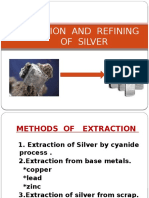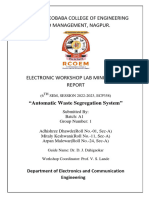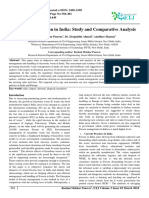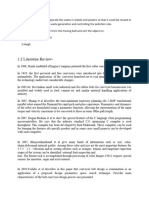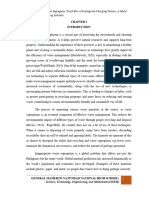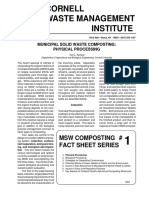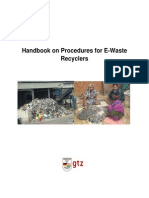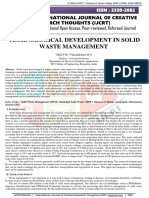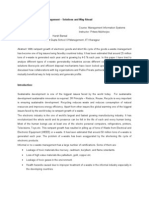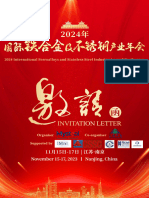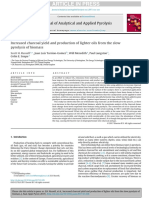Metal Seg
Metal Seg
Uploaded by
vishnu.s.eee.2021Copyright:
Available Formats
Metal Seg
Metal Seg
Uploaded by
vishnu.s.eee.2021Copyright
Available Formats
Share this document
Did you find this document useful?
Is this content inappropriate?
Copyright:
Available Formats
Metal Seg
Metal Seg
Uploaded by
vishnu.s.eee.2021Copyright:
Available Formats
See discussions, stats, and author profiles for this publication at: https://www.researchgate.
net/publication/332631009
Microcontroller Based Separation of Metal from Garbage Waste
Article · April 2019
CITATION READS
1 3,475
1 author:
Bhushan Band
Professor Ram Meghe Institute of Engineering and Management
10 PUBLICATIONS 9 CITATIONS
SEE PROFILE
All content following this page was uploaded by Bhushan Band on 25 April 2019.
The user has requested enhancement of the downloaded file.
IJSRD - International Journal for Scientific Research & Development| Vol. 7, Issue 02, 2019 | ISSN (online): 2321-0613
Microcontroller Based Separation of Metal from Garbage Waste
Prof B H Band1 A Bhandurge2 S Wath3 S Duryodhan4 V Ughade5
1
Assistant Professor 2,3,4,5UG Students
1,2,3,4,5
Department of Electrical Engineering
1,2,3,4,5
PRMCEAM, Badnera, Maharashtra, India
Abstract— The advantages of garbage separation system are However, recently municipal workers collect the
to improve the results in better minimize raw materials waste from street to street in order to dispose the waste by
wastage and reduce manufacturing costs. These benefits also proper means. Hence devise a method so as to segregate the
categorized as to improved garbage management system. The collected waste as per its proper categories. The collected
purpose of this paper is to segregate the metal and nonmetal waste is sorted into dry, wet and metal waste by employing
waste from the garbage which is major problem observed in various sensors and relays with the help of embedded C. The
the industrial and in domestic use. It is very crucial to have purpose of this project is to segregate the metal and nonmetal
some system to manage waste automatically which is waste for the industrial and domestic use. As per as the
currently not available. The Prime Minister Modi’s mission environment concern the waste garbage management is
of Swaccha Bharat Abhiyan can also be successfully today’s necessary condition. The advantages separation
implemented by the using this proposed system. To separate garbage waste to improve in energy savings, better
out metal and nonmetal waste into respective bins by sensing environmental performance, minimize raw materials wastage
of different sensors incorporated along with the conveyor and reduce manufacturing costs. The separated waste can
belt. The system has motors interfaced with the micro be sent to the recycling and processing plant instead of
controller. sending it to the segregation plant then to the recycling plant.
Key words: Metal Segregation, Waste Product, AC-DC
Motor, Microcontroller II. LITERATURE REVIEW
Following are the literature work done on garbage separation
I. INTRODUCTION system:-
Increase in population has led to improper waste management Chatterjee and Kumar [1] represented an model
in cities and also in urban areas which has resulted in where equal participation of the formal and non-formal sector
spreading different types of diseases. This paper proposes a is ensured to make the e-waste management The main
simple technique for separation of metal from waste garbage motivation for non-formal operators is to extract precious
which is a simple, easy to use solution for a segregation metals from printed circuit board (PCB) using unscientific
system at households, so that the wastes can be sent directly and unhygienic methods, which are harmful to the workers
for processing. The waste categorise into three main and the environment. Non- formal operators will concentrate
categories namely; metallic, organic and plastic, thereby on collection, disassembly, segregation of e-waste, whereas,
making the waste management more effective. Sensors are formal sector will concentrate on processing the PCBs to
added for monitoring waste collection process. The sensors extract precious metals.
would be placed in all the garbage bins. Ramahali and Mahlangu [2] studied the removal of
In India the population is one of the threat in the heavy metals from platinum industry by the process of bio-
development so as to develop the garbage system which is sorption and the advantage of this method. This method has
produced by millions of people is increases in ever year. not only provided the removal techniques for removal of
Around five million tonnes of garbage is generated in effective metals but also high post metal recovery during
metropolitan cities. The available land in the cities to dump elution. The paper gels, prepared by chemical modification of
the garbage is not sufficient most of these cities are overflow waste paper, exhibited remarkable capacity and efficiency for
with waste. It was found that about 50% people in India face the pre concentration and separation of gold, platinum and
the problem of improper waste collection and management. palladium from other co-existing metal ions at low to high
According to centre of science and environment, innovative concentration levels. Their major advantages are that they are
disposal and recycling methods must be introduced instead of usually of very low cost, decrease metal concentrations
landfill sites. Thus, we develop a simple way to manage considerably and are especially useful in waste waters
garbage system based on microcontroller for proper containing low concentrations of metal ions.
management of waste. The monitoring system overall Yoheeswaran [3] recommended the scenario,
monitor the garbage waste process. The common method of legislation and regulation in national level, e-waste recycling
waste disposal is by unplanned and uncontrolled dumping formal and informal sector in national level. In India e-waste
at landfill areas. This method is hazardous to human health, generation rate is 20% increase and to cross 805,000 tons.
plant and animal life. When garbage gets separated into the Major amount of e-waste is recycle and recovery by informal
categories then the more chances available to recycled and sector using basic methods such as open burning and acid
reuse. Compost can use for chemical fertilizers, and biogas as stripping method. The both methods are harmful to the human
source of energy. The metal waste could be reused or and environmental. It has been seen in order to maintain E-
recycled. Even if there are large scale industrial waste waste awareness should be informal sector and public for
segregators present, it is always feasible to separate the disposal of waste. The discarded material collect, separate
waste at the source itself . The benefit of doing so is that and transport by the informal sector and recycling, recovery
the occupational hazard for waste workers is reduced.
All rights reserved by www.ijsrd.com 1057
Microcontroller Based Separation of Metal from Garbage Waste
(IJSRD/Vol. 7/Issue 02/2019/288)
and disposal by the formal sector is the way of reduction of III. PROPOSED SYSTEM
pollution. We developed a system for separating out metal and non-
Patil et al. 2014[4] proposed an innovative strategic metal particles using embedded C for the domestic and
model for the recovery of valuable metal for the management industrial use. In this system the scrap materials (i.e. metal
of e-waste by employing combined technological strategies and non-metal waste) will be fed onto the conveyor belt,
viz. chemical and biological. Chemical technology involves object sensors will detect the particles on the conveyor belt
the leaching of silver from electronic scrap using toxic and start the rotation of the conveyor belt. Then, metal
chemical like cyanide. The complex silver cyanide form is sensors which are clamped to the conveyor belt will sense the
then subjected to biological technology using passive low- metal waste and stop the conveyor belt. A segregator attached
cost material. This facts helps to know the strategy to to the system will push the metal waste into its respective bin,
strengthen supply chain elements for efficient management which will be carried for further operations and the non-metal
of e-waste. waste are automatically fed into the waste dust bin.
Okwu and Onyeje [5] focuses on the good site A system depends on the metal partial present in the
extraction of valuable substances by means of recycling. The object which is moving across Sensor which is a proximity
processes involved in e-waste recycling are: collection, metal sensor. When sensor gets triggered it gives high input
dismantling, pre- processing, end processing and final metal to micro controller and micro controller starts motor for
recovery collection mechanism of e-waste is very important actuators.
because it is the determinant of the quantity of waste that is
available for recovery through recycling and the amount that
is lost in the process of storage. Dismantling is the removal
of some functioning or valuable components such as copper
cables, memories, drives, batteries, capacitors and so on
for re-use. It has been noticed that E-waste process contains
collection, dismantling, pre-processing, end processing and
final metal recovery. Fig. 1: Working Principle
Willner et al. [6] gives the bacterial leaching of An embedded system is a computer system with a
metals from various poly metallic wastes and the removal of dedicated function within a larger mechanical or electrical
metals by the process of bio hydrometallurgical method. system, often with real-time computing constraints. It is
These wastes are the carriers of valuable metals: base metals, embedded as part of a complete device often including
precious and platinum group metals. It has been seen that hardware and mechanical parts. Embedded systems control
biological leaching has been conducted in the presence of many devices in common use today.
variety microorganisms and in a wide range of waste- The proposed system uses metal sensor and
carrying base, special and precious metals. In many cases ultrasonic sensor to separate the metal waste from the waste
promising results of metals extraction were obtained. in the dust bin. The proposed system consists of two doors
Problems associated with metal toxicity towards and opens depending on the wastes. It uses a metal sensor to
microorganisms have been solved by their adaptation to high detect the metal parts in the garbage. The metal sensor
concentration of heavy metals. Although many problems contains metal detector which works on the basis principles
associated with the selection of the optimum process of electromagnetic induction. A metal detector is having one
parameters still remain to be resolved, increased efficiencies or more inductor that is generally used to interact with
of bacterial leaching operations, make these processes more metallic elements on the ground. A pulsing current is applied
competitive in relation to conventional methods. to the coil, which then induces an electromagnetic field.
Sivakumar et al. [7] studied the E- When the metal passes across the magnetic field of the coil,
waste composition, categorization, Global and Indian E- like coin, the field induces eddy currents in the coin. When it
waste scenarios, prospects of recoverable, recyclable, and detects the metal, the system will open the corresponding
hazardous materials found in the E-waste, Best Available door else for the other waste it will open other door. The
Practices, recycling, and recovery processes followed, and ultrasonic sensor will detect the presence of the object. LCD
their environmental and occupational hazards. It is display unit displays the status of the segregation process. DC
recommended that an effective take-back program providing motor is responsible for motion of the objects. Conveyor belt
incentives for producers to design products that are less is used for separation of waste particles. Arduino controls the
wasteful, contain fewer toxic components, and are easier to whole process.
disassemble, reuse, and recycle may help in reducing the The software implementation of Arduino is done
wastes. Hence creating awareness among the e- through embedded C. Embedded C is preferred over other
waste generating sectors is the important task now. Technical software languages for the following reasons:
audit and Life cycle analysis are also recommended before It is easy to understand and learn
releasing the electronic consumer product. C Compilers are available with all embedded devices
B H Band and A D Ingole [8] give detailed
Unlike assembly, C has advantage of processor-
description of dc and ac machine working for operation of the
independence and is not specific to any
system.
particular microprocessor/ microcontroller or any
system.
All rights reserved by www.ijsrd.com 1058
Microcontroller Based Separation of Metal from Garbage Waste
(IJSRD/Vol. 7/Issue 02/2019/288)
The given method gives the solution for waste
management problem which effectively separate metal, glass
and plastic. The Automated Material Segregation system
(AMS) effectively employs inductive proximity sensor to
identify metallic items, and capacitive proximity sensors to
differentiate between plastic and glass waste. This system can
be use in industries for material separation, and urban
households.
VII. FUTURE SCOPE
For further convenience transmitters could be placed at
Fig. 2: Microcontroller Based Separation of Metal from garbage dumping places to convey a message whenever the
Garbage Waste accumulation of garbage crosses its threshold limit along with
its location.
IV. RESULT
The waste segregator as the name suggests segregates the REFERENCES
waste into three major classes: plastic, organic, metallic. [1] Borthakur Anwesha, Singh Pradeep. Electronic waste in
The proposed system would be able to monitor the solid India: Problems and policies Review article,
waste collection process and management of the overall international journal of environmental sciences. 2012;
collection process. 3:353-362.
The inlet section is provided with open and close [2] Debaraj Mishra, Young-Ha Rhee. Current Research
mechanism to regulate the flow of waste on to the conveyor. Trends of Microbiological Leaching for Metal Recovery
Inductive proximity sensor is used to detect the metallic from Industrial Wastes, 2010.
waste. [3] Yoheeswaran E. E-Waste Management in India: Global
The timing and movement of the conveyor belt is research analysis. ISSN No 2277-8160 2013; 2:4.
controlled by Arduino Uno Continuous and unnecessary [4] Willner J, Kadukova J, Fornalczyk A, Saternus M.
operation of any particular section is thus avoided. Biohydrometallurgical process for metal recovery from
electronic waste. ISSN 0543-5846 METABK 2015;
V. ADVANTAGES & DISADVANTAGES 54(1)255-259.
Advantages: [5] S.Sakai, S.E.Sawell, A.J.Chandler, ‟World Trends in
Municipal Solid Waste Management‟, Environmental
1) The process is fast Preservation Centre, Vol 16, Page 341, 1996,Kyoto
2) Its efficient for separation of metal and non-metal University, Japan
3) It detect metal easily with more accuracy [6] Claudine Capel,“Innovations in Waste”, Waste
4) The separated metal can be recycled again. management-world, Volume 11, Issue 2, Mar 2010.
5) Increases in production capacity and quality. [7] Management Indore city,” IJEP, Vol. 22(8), pp. 841-846,
6) Decreases in total manufacturing cost. 2002
7) It minimizes manual work. [8] B H Band and A D Ingole, “Transfer of Power by Using
8) Its time saving and efficient Two Induction Machines” IJCESR, VOLUME-4,
Disadvantage: ISSUE-8,pp.36-40, August-2017
1) The Cost is more for small scale industries. [9] Yamazaki S, Nakane GH, Tanaka A. Basic Analysis of a
2) The Segregation system is time based hence it require Metal Detector. IEEE Instr Meas. Aug 2002; 51(4): 810–
frequent monitoring. 814p.
[10] https://en.m.wikipedia.org
VI. CONCLUSION
Automated Waste Segregator has been successfully
implemented for the segregation of waste into metallic waste
at a domestic level. However, it cannot segregate ceramic into
dry waste because of its higher relative dielectric constant
when compared to other dry wastes. Noise can be eliminated
in the sensing module to increase accuracy and overall
efficiency. The system can segregate only one type of waste
at a time with an assigned priority for metal waste. Thus,
improvements can be made to segregate mixed type of waste
by the use of buffer spaces. Since, the time for sensing metal
objects is low the entire sensing module can be placed along
a single platform where the object is stable to ensure better
results.
All rights reserved by www.ijsrd.com 1059
View publication stats
You might also like
- Bmls Princ of Inorg 2Document144 pagesBmls Princ of Inorg 2NDAYISENGA ELIENo ratings yet
- Extraction of SilverDocument21 pagesExtraction of Silversatya100% (1)
- Waste to Energy in the Age of the Circular Economy: Best Practice HandbookFrom EverandWaste to Energy in the Age of the Circular Economy: Best Practice HandbookNo ratings yet
- KS3 Science 2009 Paper 1 Level 5-7Document28 pagesKS3 Science 2009 Paper 1 Level 5-7Aryaveer Kumar100% (1)
- Rafeeq 2016Document5 pagesRafeeq 2016RohitNo ratings yet
- An Approach To Smart Waste Segregation Using IOT - Formatted PaperDocument10 pagesAn Approach To Smart Waste Segregation Using IOT - Formatted PapercharanssitNo ratings yet
- EC286Document4 pagesEC286B.AishwaryaNo ratings yet
- Smart Dustbin ReportDocument29 pagesSmart Dustbin ReportAkshay bypNo ratings yet
- BE - A - GROUP 7 Synopsis Report (Automatic Waste Segregator)Document12 pagesBE - A - GROUP 7 Synopsis Report (Automatic Waste Segregator)Rounak MunoyatNo ratings yet
- Automatic Waste Segregator and Monitoring System PDFDocument4 pagesAutomatic Waste Segregator and Monitoring System PDFAllen Kyle PrielaNo ratings yet
- Ardunio Waste 1 PDFDocument30 pagesArdunio Waste 1 PDFSushaanthika DuraisamyNo ratings yet
- Automatic Waste Segregator and Monitoring System: January 2016Document8 pagesAutomatic Waste Segregator and Monitoring System: January 2016Deepak sutarNo ratings yet
- Automated Waste Segregation SystemDocument5 pagesAutomated Waste Segregation SystemarpanmalewarNo ratings yet
- Current Research Trends of Microbiological Leaching For Metal Recovery From Industrial WastesDocument9 pagesCurrent Research Trends of Microbiological Leaching For Metal Recovery From Industrial WastesGabriella WidjajaNo ratings yet
- Automatic Waste SegregatorDocument7 pagesAutomatic Waste SegregatorGanesh Subramanian MohanNo ratings yet
- Project Final ReportDocument12 pagesProject Final ReportarpanmalewarNo ratings yet
- A Review Study of E-Waste Management in India: October 2017Document5 pagesA Review Study of E-Waste Management in India: October 2017Madhura AbhyankarNo ratings yet
- Eco-Friendly IOT Based Waste Segregation and ManagementDocument3 pagesEco-Friendly IOT Based Waste Segregation and Managementsachuakm742003No ratings yet
- Automated Waste SegregatorDocument6 pagesAutomated Waste SegregatorhimadriNo ratings yet
- Edi Research PaperDocument3 pagesEdi Research PaperPratik DixitNo ratings yet
- Synthesis of NiO Nanoparticles From Industrial WasteDocument45 pagesSynthesis of NiO Nanoparticles From Industrial WasteGunnar AgarwalNo ratings yet
- Final ReviewDocument11 pagesFinal Reviewaddalanagendra111No ratings yet
- IJCRT23A5513Document5 pagesIJCRT23A5513AMIT GANVIRNo ratings yet
- Waste Separation Smart DustbinDocument7 pagesWaste Separation Smart Dustbinsaeed shabibiNo ratings yet
- Automatic Waste Segregator and Monitoring System: Journal of Microcontroller Engineering and ApplicationsDocument7 pagesAutomatic Waste Segregator and Monitoring System: Journal of Microcontroller Engineering and Applicationsaastree01No ratings yet
- Guided By: Presented By:: Mr. Joju P John Name: Sreeraj SDocument10 pagesGuided By: Presented By:: Mr. Joju P John Name: Sreeraj SPraroop SNo ratings yet
- Unit 5 E-Waste Management NotesDocument8 pagesUnit 5 E-Waste Management NotesHariniNo ratings yet
- Case Study Revathi MamDocument11 pagesCase Study Revathi MamVishnu .SNo ratings yet
- Prachi FileDocument95 pagesPrachi FileTusharNo ratings yet
- E - Waste Legislation in India: Study and Comparative AnalysisDocument8 pagesE - Waste Legislation in India: Study and Comparative AnalysisAnusha WaniNo ratings yet
- 2STM - JoMA E DUSTBINDocument8 pages2STM - JoMA E DUSTBINBhairavi MoreNo ratings yet
- Automated Waste Segregator Project: November 2019Document11 pagesAutomated Waste Segregator Project: November 2019HELAN GRACE GNo ratings yet
- Developing An Intelligent Waste Sorting System With Robotic Arm A Step Towards Green EnvironmentDocument7 pagesDeveloping An Intelligent Waste Sorting System With Robotic Arm A Step Towards Green EnvironmentREYES, PATRICK HENDRYNo ratings yet
- Waste Managemnet Using IOTDocument6 pagesWaste Managemnet Using IOTDhanashree YadavNo ratings yet
- ReportDocument5 pagesReportzolmotespiNo ratings yet
- Smart Waste Segregation and Monitoring System Using Iot: I R J M TDocument10 pagesSmart Waste Segregation and Monitoring System Using Iot: I R J M TAira Lujille Angelique LanguidoNo ratings yet
- Waste Management: Muammer KayaDocument27 pagesWaste Management: Muammer KayaNgoni MhondeNo ratings yet
- Modern Technics For Solid Waste ManagementDocument19 pagesModern Technics For Solid Waste ManagementMy Diploma ExperienceNo ratings yet
- FinalDocument43 pagesFinalminrose073No ratings yet
- Environmental Impact of Foundries and Health Related IssuesDocument10 pagesEnvironmental Impact of Foundries and Health Related Issues20P438 - BALAJI V GNo ratings yet
- Compostare CornellDocument6 pagesCompostare CornellAntonNo ratings yet
- 2018 Waste Sorting PDFDocument7 pages2018 Waste Sorting PDFyasinNo ratings yet
- Handbook For Setting Up of An E-Waste Recycling FacilityDocument35 pagesHandbook For Setting Up of An E-Waste Recycling FacilitySachinSharmaNo ratings yet
- ssrn-3896462Document10 pagesssrn-3896462kalpitNo ratings yet
- Informal Sector Waste Recyclersin Municipal Waste Prospectsand Challenges Caseof Ahmedabad IndiaDocument11 pagesInformal Sector Waste Recyclersin Municipal Waste Prospectsand Challenges Caseof Ahmedabad IndiaNihar RNo ratings yet
- Waste Management Using Reward System: Test Engineering and Management January 2021Document5 pagesWaste Management Using Reward System: Test Engineering and Management January 2021DevangNo ratings yet
- Journal of Environmental Management: Rima Kumari, Sukha Ranjan SamadderDocument15 pagesJournal of Environmental Management: Rima Kumari, Sukha Ranjan SamadderYatharth AgrawalNo ratings yet
- Performance and Evaluation of Sewage Treatment Plant Based On MBBR and EBB TechnologiesDocument9 pagesPerformance and Evaluation of Sewage Treatment Plant Based On MBBR and EBB TechnologiesIJRASETPublicationsNo ratings yet
- Circular Economy and Household E-Waste Management in India. Part II: A Case Study On Informal E-Waste Collectors (Kabadiwalas) in IndiaDocument12 pagesCircular Economy and Household E-Waste Management in India. Part II: A Case Study On Informal E-Waste Collectors (Kabadiwalas) in IndiaPavan Sai BalamNo ratings yet
- ijaesv12n3_09Document8 pagesijaesv12n3_09garsundrohit3No ratings yet
- IJCRT2005505Document4 pagesIJCRT2005505Niva R ChandraNo ratings yet
- E Waste ManagementDocument12 pagesE Waste Managementharshbansal86No ratings yet
- UuhvDocument17 pagesUuhvjeevanantham1833No ratings yet
- Automatic Waste SegregationDocument7 pagesAutomatic Waste Segregationsankit120kNo ratings yet
- Solid Waste ManagementDocument9 pagesSolid Waste ManagementkuldipgosaiNo ratings yet
- Design For Sensor Based Waste Segregator SystemDocument10 pagesDesign For Sensor Based Waste Segregator SystemIJRASETPublicationsNo ratings yet
- Review On Current Management Practices and Environment Status of Pirana Dump Site, AhmedabadDocument9 pagesReview On Current Management Practices and Environment Status of Pirana Dump Site, AhmedabadIJRASETPublicationsNo ratings yet
- Icmiee18 33Document6 pagesIcmiee18 33muksadur rahmanNo ratings yet
- Review On Water Garbage Cleaning RobotDocument4 pagesReview On Water Garbage Cleaning Robotameenabegum140No ratings yet
- Electronic Waste and Printed Circuit Board Recycling TechnologiesFrom EverandElectronic Waste and Printed Circuit Board Recycling TechnologiesNo ratings yet
- Green Tio2 as Nanocarriers for Targeting Cervical Cancer Cell LinesFrom EverandGreen Tio2 as Nanocarriers for Targeting Cervical Cancer Cell LinesNo ratings yet
- Green Chemistry for Dyes Removal from Waste Water: Research Trends and ApplicationsFrom EverandGreen Chemistry for Dyes Removal from Waste Water: Research Trends and ApplicationsNo ratings yet
- Innovations in Autonomous Mining: Transforming the Future of Resource Extraction: MINING AUTOMATIONFrom EverandInnovations in Autonomous Mining: Transforming the Future of Resource Extraction: MINING AUTOMATIONNo ratings yet
- CorrosionDocument84 pagesCorrosionRatna ThakurNo ratings yet
- Mysteel International Ferroalloys and Stainless Steel Industry Annual Conference InvitationDocument9 pagesMysteel International Ferroalloys and Stainless Steel Industry Annual Conference Invitationantony.shiNo ratings yet
- Curriculum of The 2 Class (PE Syllabus) Part "A", First PaperDocument34 pagesCurriculum of The 2 Class (PE Syllabus) Part "A", First PaperJason FlowersNo ratings yet
- MOV Series Electric Ovens Dry Heat SterilizersDocument6 pagesMOV Series Electric Ovens Dry Heat SterilizersIkaYektiLianaSariNo ratings yet
- Complete List of Platinum Group Metals (2023)Document3 pagesComplete List of Platinum Group Metals (2023)Mohsin khanNo ratings yet
- Mostafa Barakat: All Variants in One PaperDocument356 pagesMostafa Barakat: All Variants in One PaperAhmad asaNo ratings yet
- 8 Science (Super Quiz) Formatted Sample Test Ans KeyDocument7 pages8 Science (Super Quiz) Formatted Sample Test Ans KeyVenus Tumampil AlvarezNo ratings yet
- Vibration Engg ProjectDocument10 pagesVibration Engg ProjectNeil RubsNo ratings yet
- Name: Leku Bertrand Nembo Matricle: Uba18T0183 Option: Mechanical Manufacturing Course: Materials 1 Level: 2ooDocument7 pagesName: Leku Bertrand Nembo Matricle: Uba18T0183 Option: Mechanical Manufacturing Course: Materials 1 Level: 2ooTsague Pierre YouriNo ratings yet
- Chapter 6 Welding Matl Properties & Classification VR 0905Document31 pagesChapter 6 Welding Matl Properties & Classification VR 0905khairy2013No ratings yet
- (Enppi) Corrosion & Cathodic Protection in Petroleum Industry Course (Yasser Tawfik)Document545 pages(Enppi) Corrosion & Cathodic Protection in Petroleum Industry Course (Yasser Tawfik)nachitosis100% (4)
- MetallurgyDocument4 pagesMetallurgyUpagya AwasthiNo ratings yet
- Reactivity SeriesDocument5 pagesReactivity SeriesTAKUNDA MARIMENo ratings yet
- Lecture Planner - Chemistry PDF OnlyDocument1 pageLecture Planner - Chemistry PDF OnlyJai ChandNo ratings yet
- First Term JSS3 Basic TechDocument45 pagesFirst Term JSS3 Basic TechIyanuoluwaNo ratings yet
- Thermal Insulation Products - Jacketing & CladdingDocument15 pagesThermal Insulation Products - Jacketing & CladdingSreekumar K SNo ratings yet
- Thermanit Nimo 100: Stick Electrode, Low-Alloyed, BasicDocument1 pageThermanit Nimo 100: Stick Electrode, Low-Alloyed, BasicbrayanNo ratings yet
- SGAT Bulletin June 2016Document77 pagesSGAT Bulletin June 2016Suraj MeherNo ratings yet
- Either Ore!: Lab Report Explaining Your Purpose, Methods, Results, and ConclusionsDocument4 pagesEither Ore!: Lab Report Explaining Your Purpose, Methods, Results, and ConclusionsSamNo ratings yet
- Updated Schedule A With Amendments Dated 3-3-2014Document15 pagesUpdated Schedule A With Amendments Dated 3-3-2014Pankaj GoyenkaNo ratings yet
- General Science Quiz Questions With AnswersDocument6 pagesGeneral Science Quiz Questions With AnswersJay RathodNo ratings yet
- EarthScience12 Q1 Mod3 MineralsandItsImportance v3Document50 pagesEarthScience12 Q1 Mod3 MineralsandItsImportance v3Berlyn AmanoNo ratings yet
- Article in Press: Journal of Analytical and Applied PyrolysisDocument6 pagesArticle in Press: Journal of Analytical and Applied PyrolysisiimcaemdwNo ratings yet
- HahnenDocument39 pagesHahnend3xt3rokNo ratings yet
- Chemistry Handbook and Study GuideDocument27 pagesChemistry Handbook and Study Guidepearlndlhovu72No ratings yet
- API 578 Questions PreparedDocument7 pagesAPI 578 Questions Preparedsubha100% (3)
- Module I Materials and MetallurgyDocument33 pagesModule I Materials and MetallurgyRafi UdeenNo ratings yet

